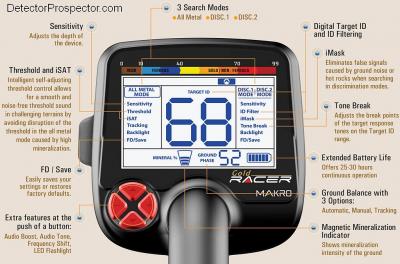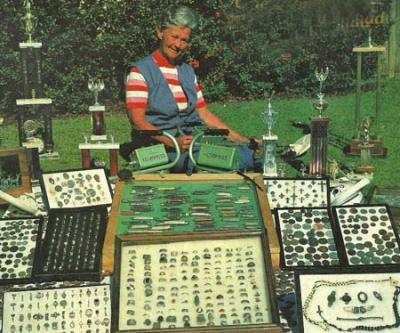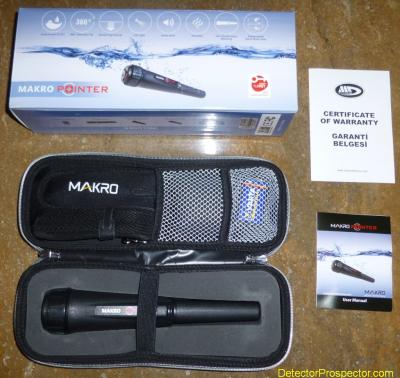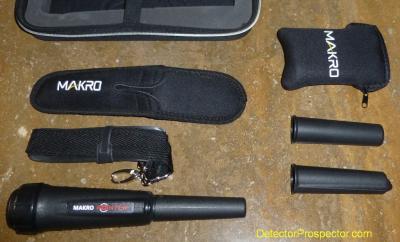-
Posts
19,718 -
Joined
-
Days Won
1,567
Content Type
Forums
Detector Prospector Home
Detector Database
Downloads
Everything posted by Steve Herschbach
-

Gold Racer - Pricing and Availability
Steve Herschbach replied to Nokta Detectors's topic in Nokta / Makro Metal Detectors
For people who may be wondering when Nokta and Makro issue MSRP pricing it is the actual price the packages will be selling for. The U.S. practice of make believe MSRP prices is actually illegal in some other countries and so they do not play that marketing game. Makro Gold Racer Full Color Brochure Makro Gold Racer User's Guide -

VLF Detectors And Depth
Steve Herschbach replied to Steve Herschbach's topic in Metal Detector Advice & Comparisons
Yes, and not all places have coins at depth. Most forums I read make a great deal of various "sink rates" regarding coins, and that no doubt holds true in moist climates with deep turf accumulations. But a lot of places with drier climates the ground surface changes but little over time and coins stay shallow even over hundreds of years. The first people in with detectors quickly got the bulk of them, no different than many nugget patches. Unfortunately, more depth, even when we can get it, just does not result in more finds. A lot of places got cleaned out of the really good stuff back in the late 60's and early 70's before we got this huge proliferation of aluminum trash. Parks really were just a lot cleaner and even the simple BFO and TR detectors of the day had no problem pulling out what would now be huge numbers of old coins. I used to subscribe to all sorts of treasure magazines back in the 70's before I ever got into nugget detecting. The magazine covers had pictures like this one of Kay Modgling on a regular basis - people finding silver by the sackful and rings by the pound. With basic non-discriminating non-ground balancing detectors! Kay was just amazing. And it may be that the very lack of discrimination played a big part in it. When I got started there was no such thing, you just dug it all. No worries about target masking! -

Condor Tries On The Insanely Hot Settings
Steve Herschbach replied to Condor's topic in Minelab Metal Detectors
Hi Tobin, welcome to the forum! Just a really great bunch of people here who love to share and help one another. There is not one of us not digging tiny bird shot, tiny steel slivers, and mineralized hot spots with the GPZ and hating it, but loving what it does all the same. Thanks for posting! -

VLF Detectors And Depth
Steve Herschbach replied to Steve Herschbach's topic in Metal Detector Advice & Comparisons
Back to the basic depth problem with VLF detectors. Metal detectors have a basic limitation in how far they can detect gold items. From http://www.talkingelectronics.com/projects/200TrCcts/MetalDetectors/MetalDetectors-1.html “the sensitivity is roughly proportional to the cube of the object diameter (as expressed as a function of the search coil diameter). Sensitivity is also inversely proportional to the sixth power of the distance between the coil and the object. All this means is that if the object size is halved the sensitivity is reduced to one-eighth. Also, if the depth is doubled the sensitivity is reduced to one sixty-fourth. It’s easy to see why all metal detectors which are designed to pick up small objects use small coils, (150 to 300 mm diameter) and really only skim the soil surface. If the search coil is doubled in diameter for greater penetration the sensitivity to small objects falls to one-eighth. You rapidly encounter the law of diminishing returns.” Famed metal detector engineer Dave Johnson reiterates this in a different way at http://www.fisherlab.com/hobby/davejohnson/davejohnsonjohngardinerinterview.htm “Getting extra depth out of a VLF, multifrequency, or PI machine is very difficult, because these machines follow an inverse 6th power law relationship between signal voltage and depth. If everything else is maintained equal, doubling the depth requires 64 times as much signal. If this is done by increasing transmitter power, doubling depth requires 4,096 times as much battery drain. That’s the basic reason why depth increases come so slowly in this industry.” -

VLF Detectors And Depth
Steve Herschbach replied to Steve Herschbach's topic in Metal Detector Advice & Comparisons
Frequency does a number of things. George Payne was one of the engineers who patented many of the basic concepts used in VLF detectors to this day. Here is an excerpt from his article at http://jb-ms.com/Baron/payne.htm (2002): "The r component acts differently. It is maximum at one particular frequency and decreases if you go up or down in frequency. We call the special frequency at which the r signal is maximum, the target’s “-3db” frequency. It also turns out that at the -3db frequency the x signal is one-half of its maximum value. This special frequency is unique to each target and is different for different target. The higher the conductivity of the target the higher will be the targets -3db frequency. Conversely, the lower the conductivity the lower the -3db frequency. The -3db frequency of the high conductivity target will also make the r signal peak at a high frequency, normally well above the operating frequency of the VLF detector. This will make the high conductivity target have lower sensitivity on the VLF detector because the r signal amplitude drops if we are significantly below the -3db frequency. Simply put, maximum sensitivity on a VLF detector would be if we position the operating frequency directly at the target’s -3db frequency. For example, a dime and penny have a -3db frequency of about 2.7KHz. This is where their r signal peaks and would be the best frequency for picking them up using a VLF detector. However, a silver dollar has a -3db frequency of 800Hz. Nickels, on the other hand, have a -3db frequency, where its r peaks, at about 17KHz. Targets like thin rings and fine gold are higher still. Clearly there is no one frequency that is best for all these targets. The best you can do is have an operating frequency that is a compromise." So that sets up the basics for air tests. The problem is we have to deal with the ground. Lower frequencies tend to be better at reducing ground issues, while higher frequencies light up both the ground and hot rocks lower frequencies might ignore. You are looking for a frequency which best lights up a target while minimizing ground effects. All in all mid frequency machines in the 10-20 kHz range offer good compromise solutions, above 20 tends to be the realm of specialized prospecting detectors, and under ten the realm of the "coin detector". Minelab messes with peoples heads because their multifrequency FBS detectors are billed as operating at 1.5 kHz all the way up to 100 khz simultaneously. Sounds like they should simply do it all, right? Super deep on coins, super hot on tiny gold. Yet this really is not the case in practice. What they do is get very accurate discrimination on coin type targets at very good depths, but compared to single frequency prospecting machines they are no depth demons. I have seen all kinds of technical arguments and explanations surrounding this which all completely ignore practical reality. Reality is these machines were designed first and foremost to deliver exceptional accuracy for coin hunters looking for silver coins in park settings, and they excel at this task. Accurate discrimination as far as it can be pushed. They despite all the marketing fluff act like really good low to moderate frequency detectors. Possibly the best silver hunters made. Focus on what they do, not what they are marketed as. These days EMI can be a big issue, and certain frequencies that in theory may work well may not in practice due to interference issues. The Fisher F75 looked great on paper but at 13 kHz fought EMI issues forever. Machines running at 19 khz seem nearly immune to urban EMI and so have an edge in that regard. Finally, frequency is just a small part of it all these days. The efficiency of the ground balance method, voltage applied to the coil (transmit gain) and receiver gain, recovery speed (reactivity) etc all play into it, so frequency alone is only a bare indicator of basic operating parameters. Still useful though and operating frequency is certainly something I still always look at when choosing metal detectors. Units like the White's V3i or XP DEUS are fascinating to experiment with because you can switch frequencies on the fly and observe the effect on found targets. One thing you will discover air testing a DEUS is that in air tests depths do not change all that much with the frequency on silver coins, but increase dramatically on low conductors like U.S. nickels or gold rings as frequency increases. Remember that aluminum is a low conductor, so using low frequencies in a park setting will do well on most coins while reducing signals on common trash. -

Nokta Gold Plus Trouble
Steve Herschbach replied to Ridge Runner's topic in Nokta / Makro Metal Detectors
I hear you Chuck and don't disagree at all. Earlier on I let Fisher off the hook regarding my personal detectors but they were the source of one of my biggest headaches relating to detector while in business. Now, this was the old Los Banos Fisher just after they sold to First Texas. At that time they made nothing much worth selling for me but the Gold Bug 2. I sold a lot of them and so placed an order for 20 of them one year. The first one I put together out of the box the ground balance knob fell off. The next one would not ground balance at all. About 1/4 of the detectors were bad out of the box and had to be sent back. I was so irritated I just stopped ordering any more Fisher product. Finally one day I got a message from Dave Johnson himself. He explained that when they bought Fisher that First Texas also got a warehouse full of product that got sold and shipped. Unfortunately they had no idea at the time how bad the old operations were at the end but assured me he now had the mess cleaned up and asked me to give them another chance. I of course did so (who could say no to Dave?) and everything was fine from then on out. All I can say is if you are ever buying a used Fisher detector, avoid anything made in at least that least year before the sale to First Texas or immediately after. Quite a few bad CZ detectors got shipped also in that time frame. Many worked but were not calibrated properly so very poor performers. -
I have been thinking for some time how it might be nice every once in awhile to recognize somebody on the forum in a special way. I thought about doing a poll but that seemed like it could get into some kind of popularity contest with ballot box stuffing and hurt feelings so I just decided to make it simple. My forum, my pick! There is a guy on the forum who goes by vanursepaul. Back in March he did something that really made me sit up and take notice. He gave his White's MXT away to a total stranger on the forum! The story need not be told here and I have since wondered about the individual Paul gave the detector to, but there is no doubt it was a special act by a special person to do what Paul did. This was back in March at http://www.detectorprospector.com/forum/topic/737-thank-you-to-all-the-men-and-boys-at-this-forum/?p=6731 Further, Paul works at the VA supporting our veterans. Now, I will admit to being a peacenik of sorts and there are few if any military actions that have taken place in my lifetime that I think were worth a drop of American blood. Regardless of that however I have an very deep and abiding respect for the men and women who serve in the military. There is no doubt that having a strong military is vital to the nation, and that without the willingness and sacrifices of the men and women in uniform I would not enjoy anything like the life I have had, because of people like them willing to put their lives on the line for me. I am awed and humbled by them all. You all have my greatest respect and I thank you for the jobs you do or have done. That also goes very much to people like Paul who look out for the interests of our veterans in any way and at any level. There are those that have paid a serious price for serving our country and we can never do enough to help them. Thank you Paul. Then I saw that Paul was the first person I know of to jump on ordering a new Makro Gold Racer and it all clicked. Paul was the obvious candidate. Dilek Gonulay with Makro is my partner in crime here because she provided me with a brand new Makro Pinpointer to give to Paul for use with his new Makro detector when it arrives. There is not a more deluxe pinpointer package on the market and totally waterproof also. It comes in it's own little hardcase and even has a couple special slip on protective tips for use scraping and poking around in rough conditions. So I met Paul today and bought him lunch and gave him the pinpointer Dilek sent me. Thank you for the donation Dilek. Congratulations Paul Kirkeminde - Detector Prospector Man of the Year!
-

Nokta Gold Plus Trouble
Steve Herschbach replied to Ridge Runner's topic in Nokta / Makro Metal Detectors
Well, I used to run a service department dealing with all sorts of products. All warranties pretty much say the manufacturer will repair or replace the item at their option. I almost never saw any company do a full product replacement unless it was something small and pretty much one piece. Like a bilge pump for instance. It fails under warranty, they replace it. After saying you ran it dry or sucked up fishing line or hooked it up backwards, etc. I am not saying this to defend Nokta per se but that is just how things are normally done. If you get a detector with a bad coil, any company is going to replace the coil, not the whole detector. Or in this case a handle, whatever. Now, having said that this is where a local dealer does come in. If you had bought the detector from me when I was a dealer, first, you probably would not got out of the door until we put it together and checked it out unless you insisted. If that happened and you brought it back next day, I would have replaced either the detector or the failed part on the spot and sent you on your way, and then taken it up with the manufacturer on my own. That level of service is rapidly becoming non-existent as people turn to the internet and mail order for everything. Even then however I personally believe a dealer always has primary responsibility for everything they sell, and way too many dealers these days just fob it off on the manufacturer. Most dealer agreements I ever signed made it clear that part of the deal is taking care of customer issues. So when I hear dealers say stuff like "I did not make it so it is not my problem" my answer is "my money is in your pocket, so it is". The dealer is the last line of defense. We can blame the manufacturer for letting a bad in box unit out of the door, sure. But how about the dealer who did exactly the same thing? I see on the forums a lot these days people just take it straight to the forums and the manufacturer and the dealers seem to be 100% off the hook these days and I just do not get that personally. If that is how it is to be then as a manufacturer I would cancel all my dealers and go factory direct for everything. Why share the profit with people who do not earn it? By the way this was not aimed at you Chuck. I just got started and riffed on about something that has been bugging me for awhile. -

Condor Tries On The Insanely Hot Settings
Steve Herschbach replied to Condor's topic in Minelab Metal Detectors
Glad to hear my settings are at least getting some more experimentation going. They simply will not work as published for many people in some ground locations - I always want to be clear on that. But for people who like running hot they can provide some extra pop in the right locations. Can't wait to hear the followup as I am off season right now and not seeing any gold myself. -
If we all read manuals and understood them my forum would be out of business! Welcome to the forum usefy_eng and thank you for bearing with me while I got you online. First off, I have to say I have never heard of anyone yet suceessfully employing the Coin & Relic Mode. Despite its name, it really has nothing to do with Coins & Relics. Here is the quote from the link cited above: "Coin/Relic is designed for use in lightly mineralized soils including many beaches. It offers maximum detection depth on a range of target sizes, significantly greater than any other timings. However, if the ground is any more than lightly mineralized, the detector may not ground balance. Coin/Relic should work very well in most common parks, ovals, and old home sites, so is the preferred timing when using your detector for coins, jewelry and relics. On ocean beaches containing significant quantities of black sand, better results may be had by using Normal or Salt settings." In other words, by design the Coin & Relic timing is already using an extremely limited amount of ground balancing, so minimal that ground balancing simply will not work at most locations if you use this timing. So my first answer to your question is that it may not matter what else you do if you use Coin & Relic in the vast number of locations where it will not work. Your first clue will be that the detector will pick up the ground if the coil is raised and lowered over the ground, despite any changes to the ground balance settings. Another tip for Coin & Relic timing is to use very low gain settings to reduce ground effects. I strongly advise you start elsewhere, and a good place to start is at GPX Help For A Beginner If the GPX is run in ground tracking mode it constantly adjusts the ground balance for you. Holding the green button on the handle pauses the tracking while you are over a target so as to not track it out. The tracking speed determines how aggressive the tracking system is. Fast tracking will do a better job in highly variable ground but may tend to track out tiny or deep targets so is actually only used if you really need it. If the detector can't keep up with changes in the ground. Another solution is just go slower. Slower tracking speeds do force you to move slower in bad ground, but are preferred for maximum depth and sensitivity where you can use them. Most operators prefer no tracking at all. Turn tracking off. Now the green button temporarily turns automatic ground balance on. Hold the button and pump the coil over the ground until the ground signal goes away, and release the button. Now you have a fixed ground balance setting, and only set it again if the ground conditions change. If you yse Coin & Relic tracking may be best because that mode will be very sensitive to even slight changes in ground conditions. If you are trying to use the detector for coins or relics, ground balancing over targets is a real bad idea. The only discrimination you have available that works to full depth is the sounds the detector makes, and the best way to learn them is to listen to the sounds, then dig the item up and see what made the sound. Eventually you will learn small items or low conductor items make a hi-lo tone, and large items or high conductive targets make a lo-hi tone. Finally, if you use a DD coil you can use the Discrimination control to blank out shallow ferrous {steel and iron) targets but it is unreliable and does not work on deep targets. The GPX 5000 is designed first and foremost for depth. Any discrimination is a secondary attribute. Relic Hunting with the GPX 5000 http://www.treasurenet.com/forums/today-s-finds/230759-new-gpx5000-digs-diggin-virginia-xvii.html
-
The whole depth with single frequency VLF detectors thing in my opinion has been nothing but a red herring for decades. I have read a thousand posts from people wanting VLF detectors with "more depth". Yet VLF detectors maxed out for usable depth by at least 1990 if not before. I have not used any single frequency VLF metal detector since 1990 that got more depth on coins than my old Compass Gold Scanner Pro. The only real improvement we have seen and are still seeing is in the ability to find and correctly identify items that are masked by the ground itself or adjacent undesirable targets. There are an amazing number of targets in the ground at depths achievable by any decent detector made in the last 25 years, but that are being missed because they are improperly identified and ignored, or just completely masked and invisible. This is an area where the Minelab BBS and FBS detectors have excelled. They do not go deeper. They simply get more accurate discrimination at depths exceeding what most detectors achieve. Machines like the DEUS and a lot of other Euro machines are excelling not for the depth they get, but this ability to acquire and accurately identify targets at shallower depths that are missed by other detectors. If we had a detector that could simply see through everything and accurately identify coins to 10" the ground would light up with countless missed finds. I get a chuckle out of all the deep coins I see people talk about on the forums when the best detectors made can't accurately identify a dime past 5-6 inches in my soil. Anything deeper just gets called ferrous. There is huge room for improvement in metal detectors still not by getting more depth, but by simply finding shallower targets that have been missed by other detectors made up until now. How To Make Yourself Crazy! U.S. Versus Euro Style Detectors
-

Minelab Bundles GPX 4500 and SDC 2300
Steve Herschbach replied to Jim Taylor's topic in Minelab Metal Detectors
I have never tried the SDC on a salt water beach. I only put it in the water once, up at Lake Tahoe. The main thing I discovered is the SDC 2300 floats like a cork whereas the ATX is pretty much neutral in the water. I think the SDC makes a better wading unit than a fully submersible machine. The only guy that seems to have really put the SDC to the test in salt water is Gary Drayton http://www.minelab.com/treasure-talk/beach-hunting-with-the-sdc-2300 That is a heck of a deal for the right person. -

Dankowski Report On FORS Gold Plus
Steve Herschbach replied to Steve Herschbach's topic in Nokta / Makro Metal Detectors
Actual field testing now commencing at http://www.dankowskidetectors.com/discussions/read.php?2,95264,95385#msg-95385 -

Nokta Gold Plus Trouble
Steve Herschbach replied to Ridge Runner's topic in Nokta / Makro Metal Detectors
I have not been quite as lucky but I have owned a LOT of detectors. So far have had to send back Garrett, Minelab, Tesoro, and White's units for warranty work. I have owned a lot of a Fisher machines but can't recall one ever needing warranty. I did send a Gold Bug 2 back once just to get it tuned up, but that is it as far as I can remember. So far no issues with the Turkish models. -

Tesla App Based Detector?
Steve Herschbach replied to Ringmoney's topic in Metal Detector Advice & Comparisons
They make hundreds of things that fix the dirty finger issue for cell phones. I can get totally submersible cases for my iPhone. Underwater detector! I do not see the DEUS control box as being any less prone to wet dirty finger issues. The fact is once the detector is set up you don't play with the controls much if at all anyway. Whoever does this right is going to score. Most old line companies will avoid it because it will eat into what most mainly sell you, which is the control box and what is in it. But XP has proven the working guts can all be in the coil, and the box is just a control and display interface. Hey, I am the old fashioned give me a wired coil guy here. But I can tell a big seller when I see it. Even if it were just a basic park coin shooter it would appeal to a very large market. I know this Russian detector is not it but the concept is a gold mine for the outfit that does it right. Sell me the coil and make the app open source so we can all modify if we wish and watch the combined ingenuity of the community take over. -

Nokta Gold Plus Trouble
Steve Herschbach replied to Ridge Runner's topic in Nokta / Makro Metal Detectors
I would lay my money on the handle also so we will see. Crossing my fingers that it fixes you right up! -

Tesla App Based Detector?
Steve Herschbach replied to Ringmoney's topic in Metal Detector Advice & Comparisons
Dirty hands and touch screens being used around the world as I type. That is why all those screen savers get sold. I doubt these guys have it right but somebody will get it done. Wish I knew more about electronics, I would jump on the idea myself. -

Paul's Insanely 'Not Hot' Smooth Settings...
Steve Herschbach replied to vanursepaul's topic in Minelab Metal Detectors
Excellent, congrats Paul, could not happen to a nicer guy! -
Here is the 1904 Edition at Google https://books.google.com/books?id=vWY1AAAAMAAJ&pg=PP1&lpg=PP1&dq=Geology+Applied+to+Mining+by+Josiah+Edward+Spurr&source=bl&ots=bzQM7aHsqL&sig=unyRG6BO8qy2ZmMSmsfCSxvC3P8&hl=en&sa=X&ved=0ahUKEwiQzd6YxcjJAhWEFx4KHUNdDWoQ6AEIQzAH#v=onepage&q=Geology%20Applied%20to%20Mining%20by%20Josiah%20Edward%20Spurr&f=false You can read the 1926 second edition online at http://babel.hathitrust.org/cgi/pt?id=uc1.$b315479;view=1up;seq=7 Other publications by Spurr http://onlinebooks.library.upenn.edu/webbin/book/lookupname?key=Spurr%2C%20Josiah%20Edward%2C%201870-1950 Wikipedia on Josiah Edward Spurr (1870 - 1950) https://en.wikipedia.org/wiki/Josiah_Edward_Spurr He has been a part of my entire life in a way - Mt. Spurr west of Anchorage, a very active volcano that has dumped ash in my yard in the past, was named after him. In fact, I still have a bottle full of that ash. Alaska Mining Hall of Fame Entry - Do take a look at this, interesting read! http://alaskamininghalloffame.org/inductees/spurr.php
-

Tesla App Based Detector?
Steve Herschbach replied to Ringmoney's topic in Metal Detector Advice & Comparisons
It would seem inevitable when you look at what XP has done with wireless coils. Everyone already owns the best color screen control box billions of dollars can make, with screens and processing power galore. And built in GPS! Take calls while detecting - well, that might not be a selling point but you get my drift. Another great idea that should be happening here first but instead we are seeing it from overseas. I am sure it has limitations but the way tech is advancing it really is just a matter of time. -
What really stuns me is the size of these ships in the early 1700's. A crew of over 600 - I find that simply amazing. The battle was known as "Wager's Action" with details at Wikipedia https://en.m.wikipedia.org/wiki/Wager%27s_Action Action Off Cartagena, 28 May 1708. Oil by Samual Scott (public domain)
-
Cartagena (Colombia) (AFP) - Colombia says it has found the shipwreck of a storied Spanish galleon laden with gold, silver and precious stones, three centuries after it was sunk by the British in the Caribbean. "This is the most valuable treasure that has been found in the history of humanity," President Juan Manuel Santos declared on Saturday. The San Jose was sunk in June 1708 near the Islas del Rosario, off Colombia's Caribbean coast, during combat with British ships attempting to take its cargo, as part of the War of Spanish Succession. The galleon was the main ship in a treasure fleet carrying gold, silver and other valuable items from Spain's American colonies to King Philip V. Only a handful of the ship's crew of 600 survived when the San Jose sank. The loot is estimated to be worth around $2 billion, its value having dropped significantly due to the falling price of silver, according to US-based company Sea Search Armada. Full story at http://news.yahoo.com/colombia-finds-treasure-galleon-ending-300-mystery-230419797.html
-

Dankowski Report On FORS Gold Plus
Steve Herschbach replied to Steve Herschbach's topic in Nokta / Makro Metal Detectors
Concentrics do have better ferrous id capabilities over DD coils so it is not entirely unexpected? The catch with Tom is all his tests are in low mineral ground. He gets depths double in Florida over what I get on the west coast. The mineralization also adversely affects concentric coils. May be more to that story once he does some real world testing. This opens up possibilities because I have a FORS Gold Plus in hand and just got my new DEUS so if the weather cooperates I can do a little checking to try and confirm all this, plus see what happens with the new DEUS coil. I also wonder how the FORS Gold Plus handles flat steel, as that is their weakness compared to the DEUS and CTX.








